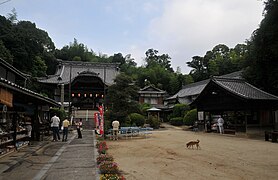Enmei-ji (Imabari)
The Enmei-ji ( Japanese 延命 寺 ) with the Go Chikamizan (近 見 山) and Hōshōin (宝 鐘 院) is a temple of the Buzan direction (豊 山 派) of Shingon Buddhism in the city of Imabari (Ehime Prefecture). In the traditional count, it is the 54th temple on the Shikoku pilgrimage route .
history
According to tradition, the temple was laid out at the request of the emperor Shōmu (reign 724 to 749) by priest Gyōki on the 244 m high mountain Chikamizan, where he made a sculpture of the holy Fudō (不 動 明王), who is in the Dainichi -Buddha (大 日 如 来) transformed. Later, at the request of the saga , priest Kūkai rebuilt and expanded the temple complex (伽藍, Garan) to include teaching buildings and gave it the names Enmyōzan (圓明 山) and Fudōin (不 動 院). It stays that way until the Meiji Restoration , but because there was already the 53rd temple of the Shikoku pilgrimage in Matsuyama in this spelling, the Enmyō-ji , this was now officially related to the people in the Edo period . The temple was ravaged by fires repeatedly until it was finally moved from the mountaintop of Chikamiyama to the foothill about 2 km south in 1727, where it has been since then.
During the Kamakura period , priest Gyōnen (凝 然; 1240-1321) built a hermitage in a western side valley in 1268, in which the beginners introduced Buddhism with a textbook he called "Hasshū kōyō".
The attachment
After you have passed the Niō gate (仁王 門) and crossed a parking lot, you reach the temple gate (山門, Sammon; 1). This was a gate of Imabari Castle and was moved here when it was demolished. Immediately behind it is the Yakushi hall (薬 師 堂; 5) and on the right, surrounded by trees, the small bell tower (鐘楼, Shōrō; 4). In advance you reach the main hall (本 堂, Hondō; 2) via a few steps. The front section shows a curved "gable section in the Chinese style" (唐 破 風, Karahafu). - The somewhat secluded hall, which is dedicated to the temple founder, the Daishidō (大師 堂; 3), can be reached via a staircase.
On the temple grounds there are the second oldest stone pilgrimage markers of the priest Shinnan (真 念, early Edo period ) and the Aseba trees (馬 酔 木), which bloom white from November to January.
photos
Remarks
- ↑ "Hasshū kōyō" (八 宗 綱要) are the eight early beliefs of Buddhism, Kusha (倶 舎), Jōjitsu (成 実), Ritsu (律), Sanron (三 論), Tendai (天台) and Kegon (華 厳).
literature
- Oguri, Doei: Kukai. Shikoku hachijuhachi kosho no arukikata. Chukei no Bunko, 2011, ISBN 978-4-8061-4067-2 .
Web links
Coordinates: 34 ° 4 ′ 0.6 ″ N , 132 ° 57 ′ 50.4 ″ E







